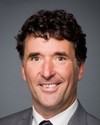Thank you, Chair. Bonjour, everyone. Thank you for the invitation and opportunity to speak today. I really appreciate it.
I want to apologize for not speaking French today.
I first went to the Arctic in 1994 on an expedition to the top of Ellesmere Island. Little did I know at the time that this first Arctic journey would be one of the turns in my life's path and an experience that would go on to define my career and, really, my life in many ways. Soon after it led me to the Antarctic. Someone figured that, since I'd been to the Arctic, I must know something about the Antarctic, so I agreed with them. In reality I barely knew the difference between a polar bear and a penguin, but away I went.
In the two decades since, I've had the great fortune to lead over 80 expeditions to the Antarctic and 40-odd expeditions and projects throughout the circumpolar Arctic. I've sailed through the Northwest Passage three times, stood on the tops of remote mountains and glaciers, and looked into the eyes of polar bears and bowhead whales. I've listened to and learned from Inuit elders, participated in scientific research, and witnessed firsthand the impacts of climate change, including being stuck up to my knees in melting permafrost. I've walked into the depths of one of the first mining operations in the Canadian Arctic and I've had very emotional conversations with Inuit youth about why suicide should not be considered an option. From the pure awe and wonder of the land to the traditional knowledge and remarkable resiliency of the Inuit, the Arctic has cast a spell on me like it has on so many others.
My Inuktitut name is Pitsiulak, which was given to me by Ann Hanson, the commissioner of Nunavut at the time. A pitsiulak is a black guillemot, a small Arctic bird with bright red feet. It's also in the name of Peter Pitsiulak who was a great educator and artist from Cape Dorset. The school in Cape Dorset is named after Peter. That name has come to mean a lot of things to me but is mostly a reinforcement of my connection to our north and its people.
I've come to appreciate and understand how the polar regions truly are the cornerstones of our global ecosystem and how everything is interconnected in between. Like the battery in your car, if the two poles are not connected, your car doesn't start. The polar regions of our planet are critical to the way the oceans circulate, the stability of our climate, and, really, to life on earth as we know it and enjoy it. In this way and many others, the Arctic and the Antarctic are windows to our world. They're remarkable symbols of peace and understanding and of collaboration and conservation.
I would be remiss if I did not mention that Canada remains a non-consultative member of the Antarctic Treaty. Becoming a full member of the Antarctic Treaty would be warmly welcomed on the international stage and would certainly serve to strengthen our position as a great polar nation and add weight to our Arctic foreign policy at very little cost.
The Canadian Arctic is so many things. It is our biggest coastline that links our nation from sea to sea to sea and represents 40% of our land mass. I love the idea of changing our national motto to include the Arctic Ocean: A Mari usque ad Mare usque ad Mare. Wouldn't that be a profound way to help celebrate Canada's upcoming sesquicentennial in 2017?
The Arctic is a huge part of Canadian identity. We are a polar nation. We would be very different as a nation and a people if it were not for this vast land and ocean stretching above us all the way to the North Pole. As Bernie Funston likes to say, and I know he presented to you recently, the Arctic is a “homeland, a frontier, a laboratory and a wilderness”. I'd like to add to that list because I believe it is also the world's greatest classroom.
In 1999, I founded Students on Ice, a program to take youth from across Canada and around the world on educational expeditions to the Arctic and the Antarctic. In the last 13 years we've taken over 2,000 students from 52 countries on these journeys; secondary and post-secondary students from every province and territory in Canada, including hundreds of northern aboriginal youth from the Yukon to Nunatsiavut. We've also had students from countries such as Afghanistan, Iran, Russia, New Zealand, Chile, South Africa, China, India, Israel, and Palestine.
On each ship-based expedition, the students travel with world-class teams of educators, elders, scientists, experts, artists, musicians, and leaders of all stripes—even politicians. Today, I'd like to invite all of you to join us on a future Arctic expedition. The next one is in July.
We've worked closely with members of Parliament, senators, congressmen and congresswomen, premiers, presidents, and even princes. Prince Albert II of Monaco is the honorary chair of my board of advisers.
Together with these partners, we're active in all kinds of related global educational initiatives. We reach hundreds of thousands of youth each year through conferences, new media, and different activities. Our growing alumni and alumni program are really well positioned to champion Arctic Council initiatives that respond to the needs of northern Canadians and connect the themes of Canada's Arctic Council chairmanship, Canada's Arctic foreign policy, and northern strategy objectives.
We possess, together with these students, a unique convening power to bring together many diverse stakeholders on Arctic issues. The impact and outcomes on the students, as you can imagine, are diverse, quite extraordinary, and quite inspiring, from personal levels to becoming Arctic ambassadors, by sharing their experiences with their communities back home, and in many cases representing Canada on an international stage. Most recently, some of the alumni tabled the International Youth Arctic Declaration at the senior Arctic officials' meeting of the Arctic Council in Luleå, Sweden.
All the students are fully supported by scholarships via our Students on Ice Foundation, and that's thanks to generous support from private and public sector partners. I can safely say that if not for Canada, Students on Ice would not exist, and we've been blessed to work with all kinds of government departments from INAC, Heritage, Environment, DFAIT, Canadian Wildlife Service, Parks Canada, and the list goes on. We are also quite involved in the International Polar Year, and the Canadian Museum of Nature is our biggest partner.
I want to commend this committee for the important and timely initiative that you're taking on. There's a perfect storm of governance challenges and opportunities that face the Canadian government with respect to the Arctic region. Canada's upcoming chairmanship of the Arctic Council puts us in a great position to lead, to show Canadians in the world why we are a great polar nation, and to make the decisions that we can be proud of and that will benefit generations to come.
I would also like to urge the committee to take a long-term view of international sustainable development in the Arctic. I strongly support the ecosystem-based managed and balanced approach to economic development and protecting the environment in the Arctic, as stated in the foreign policy. We must keep in mind at all times that good human industrial activities can have unintended effects. A recent example is about how narwhal whales migrating out of summer feeding grounds in the Canadian Arctic Archipelago into Baffin Bay were turned back by seismic exploration. The whales of course use echolocation in a quiet ocean to hunt and navigate. They became trapped at breathing holes in the channels of the islands until it was too late for them to reach open water, when the holes froze up. They starved, and they died.
In 2008, about 1,000 trapped narwhals were counted near Pond Inlet. This kind of problem will likely increase as industrial activity increases, unless it's mitigated and studied properly. Certainly, the petroleum exploration people never intended to kill thousands of whales several hundred kilometres distant from their operations. It shows how in the Arctic, all activities, both human and natural, are connected. Even short-term activities can have long-term impacts.
Canada has identified environmental stewardship as being central to the sustainable development of the natural resources in the north, and that's great. Achieving this will require building leadership in the north and proving the capacity of northern communities to respond to the challenges and opportunities, especially due to the result of climate change.
I'd like to focus my remaining comments on the important role education will play in all of this, because it's truly fundamental. Broadly speaking, there are two main areas of education in dire need of improvement vis-à-vis the Arctic: education in the north for northerners and northern youth, and public education in the south about the north.
Across the Arctic, there are children and youth full of curiosity, hope, and dreams, and some amazing young emerging leaders, whom we should be proud of.
But too many of these youth are struggling, to put it mildly. I'm sure you're aware of the appalling statistics and circumstances: 75% of Inuit youth are not graduating from high school; many don't attend school; and 56% of the Inuit population are under the age of 25. It is a bit of a recipe for disaster. That's why it's such an urgent issue. And of course this educational disparity between non-aboriginal and aboriginal Canadians exists across the country; it's one of our greatest challenges.
What does improving education in the north mean? It's not just a matter of implementing new systems and curriculum. Improving this situation is intrinsically linked to some very basic needs, such as for adequate housing infrastructure. Sustainable, healthy, prosperous, and well-educated northern communities must be a pillar and priority in our Arctic policies.
Initiatives such as the 2011 national strategy on Inuit education, the Nunavut Sivuniksavut program here in Ottawa, the Nunavut Arctic College, and the new Amaujaq National Centre for Inuit Education are doing great work in this area and deserve more support.
With regard to public education and understanding about the Arctic for southern Canadians, there remains a remarkable void and disconnect. As an anecdotal example, during a recent workshop that my team was giving at one of Canada's teachers' colleges, the question was asked, how many of you learned about the Arctic in school? Not one of the teachers raised a hand. As a polar nation, we still have very little Arctic-related curriculum in our mainstream education systems. We need to change this.
Canada can and should be a leader in Arctic education. Our youth love to learn about the Arctic—its history, culture, flora, fauna, sciences, the contemporary issues facing the Arctic. As a platform for education I've never seen anything that comes close to the Arctic. Filling this void is also about bridging north and south, building trust and understanding, breaking down the misconceptions and stereotypes. It's also about preparing our youth in the best possible way for the future. We must take on this active role on so many levels.
With regard to climate change, from an educator's point of view it is our responsibility to help prepare this next generation for the kind of world they'll be living in as adults. During one of my many polar journeys with Dr. Fred Roots, one of our country's legendary polar statesmen, he said to us:
To pass a torch in civilization, just as in a relay race, the person you are passing it to has to be ready to take it or else it will get dropped. It is the duty of all of us to say enough about what kind of a race we are in, and what are the rules of that race, before we pass the torch.
As an aside, Dr. Roots dropped a flagpole on the North Pole in 1969, well before our Russian neighbours did in 2007. However, when he dropped the flagpole, it had all the flags of the United Nations on it. It's still there today; what a remarkable gesture—much more symbolic and appropriate.
To conclude, there are four education-related projects I wish to share with you that I think would be wonderful ways to showcase and build on Canada's arctic foreign policy, northern strategy, and chairmanship.
The first is Polar House, or Arctic House, a national centre to raise awareness about and to celebrate the past, present, and future of the Arctic.
The concept of a national centre to support Canada's Arctic is not new. In 1987, the Department of Indian and Northern Affairs published the report Canada and Polar Science. One of its chief recommendations was the establishment of a polar house or Arctic house.
I worked quite a lot on this throughout the IPY, and there is a full business plan that I'd be happy to share with any of you. It would support Canada's Arctic foreign policy by building public support for the exercise of Canadian sovereignty, a platform for policy, technical dialogue, education, social and economic development, environmental protection, and on and on it goes.
Other countries, such as Norway, Russia, and New Zealand, have polar houses, and I think Canada deserves a polar house. I even have a location, if you're interested.
The second project is the creation of a global, unique polar or Arctic school, an international, semester-based school based in the capital region that would draw youth from across Canada and around the world to study Arctic issues, build knowledge and capacity, and have a field school component whereby students then participate as interns in scientific, northern community-based development projects and expeditions in the Arctic. A broad range of partnerships would make this a global, unique, Canadian initiative.
The third is the establishment of an ongoing Youth Arctic Council, a parallel organization. Our youth represent the true sustainable future of the Arctic. Engaging them at an early stage in the workings of the Arctic Council would empower them to act as champions and catalysts, which would assist and actually feed the real Arctic Council with vision, ideas, and strategic planning. They could probably talk as well about things that the real Arctic Council can't talk about. This Youth Arctic Council could meet both physically and virtually, and it could be a great outcome of our chairmanship.
Lastly is the virtual Arctic project, for which we're already working on phase one, in partnership with the Museum of Nature and Heritage Canada. It's an educational resource for Canadian youth from coast to coast to coast, and it is a project that will go a long way to fill that void of Arctic curriculum in Canada.
Merci beaucoup.
I look forward to any questions and to helping make these initiatives and others a reality in the future.






